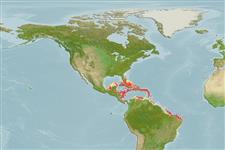>
Ovalentaria/misc (Various families in series Ovalentaria) >
Grammatidae (Basslets)
Etymology: Lipogramma: Name formed from 'lipo' for 'without' and 'gramma' for 'a line of text', referring to the absence of a well-developed lateral line.; evides: Name from Greek meaning 'comely'..
More on authors: Robins & Colin.
Environment: milieu / climate zone / depth range / distribution range
Écologie
marin démersal; profondeur 45 - 365 m (Ref. 26884). Deep-water
Western Central Atlantic: Bahamas and Central America to Lesser Antilles.
Taille / Poids / Âge
Maturity: Lm ? range ? - ? cm
Max length : 4.0 cm TL mâle / non sexé; (Ref. 7251)
Épines dorsales (Total) : 12; Rayons mous dorsaux (Total) : 9; Épines anales: 3; Rayons mous anaux: 7 - 8; Vertèbres: 25. This species is distinguished by having D XII, 9; A III, 7-8 (the last composite); pectoral, 15-16; pelvic I, 5 (the outer 2 segmented rays elongate, extending well beyond the anus); principal caudal rays 17; vertebrae 25 (10 + 15); total gill rakers 20-21; branchiostegals 6 (4 + 2); no lateral line canal on body; maxilla naked; head and body crossed vertically by 3 violet-brown bands (Ref. 13761).
Life cycle and mating behavior
Maturities | Reproduction | Spawnings | Egg(s) | Fecundities | Larves
Robins, C.R. and G.C. Ray, 1986. A field guide to Atlantic coast fishes of North America. Houghton Mifflin Company, Boston, U.S.A. 354 p. (Ref. 7251)
Statut dans la liste rouge de l'IUCN (Ref. 130435)
Menace pour l'homme
Harmless
Utilisations par l'homme
Pêcheries: commercial; Aquarium: Commercial
Outils
Articles particuliers
Télécharger en XML
Sources Internet
Estimates based on models
Preferred temperature (Ref.
123201): 16.8 - 26.2, mean 22.1 °C (based on 44 cells).
Phylogenetic diversity index (Ref.
82804): PD
50 = 0.5003 [Uniqueness, from 0.5 = low to 2.0 = high].
Bayesian length-weight: a=0.01122 (0.00514 - 0.02450), b=3.04 (2.87 - 3.21), in cm total length, based on all LWR estimates for this body shape (Ref.
93245).
Niveau trophique (Ref.
69278): 3.2 ±0.4 se; based on size and trophs of closest relatives
Fishing Vulnerability (Ref.
59153): Low vulnerability (10 of 100).
